2.6 When Does the Ownership Model Work and When Does it Not?
I have a definition of success. For me, it’s very simple. It’s not about wealth and fame and power. It’s about how many shining eyes I have around me.
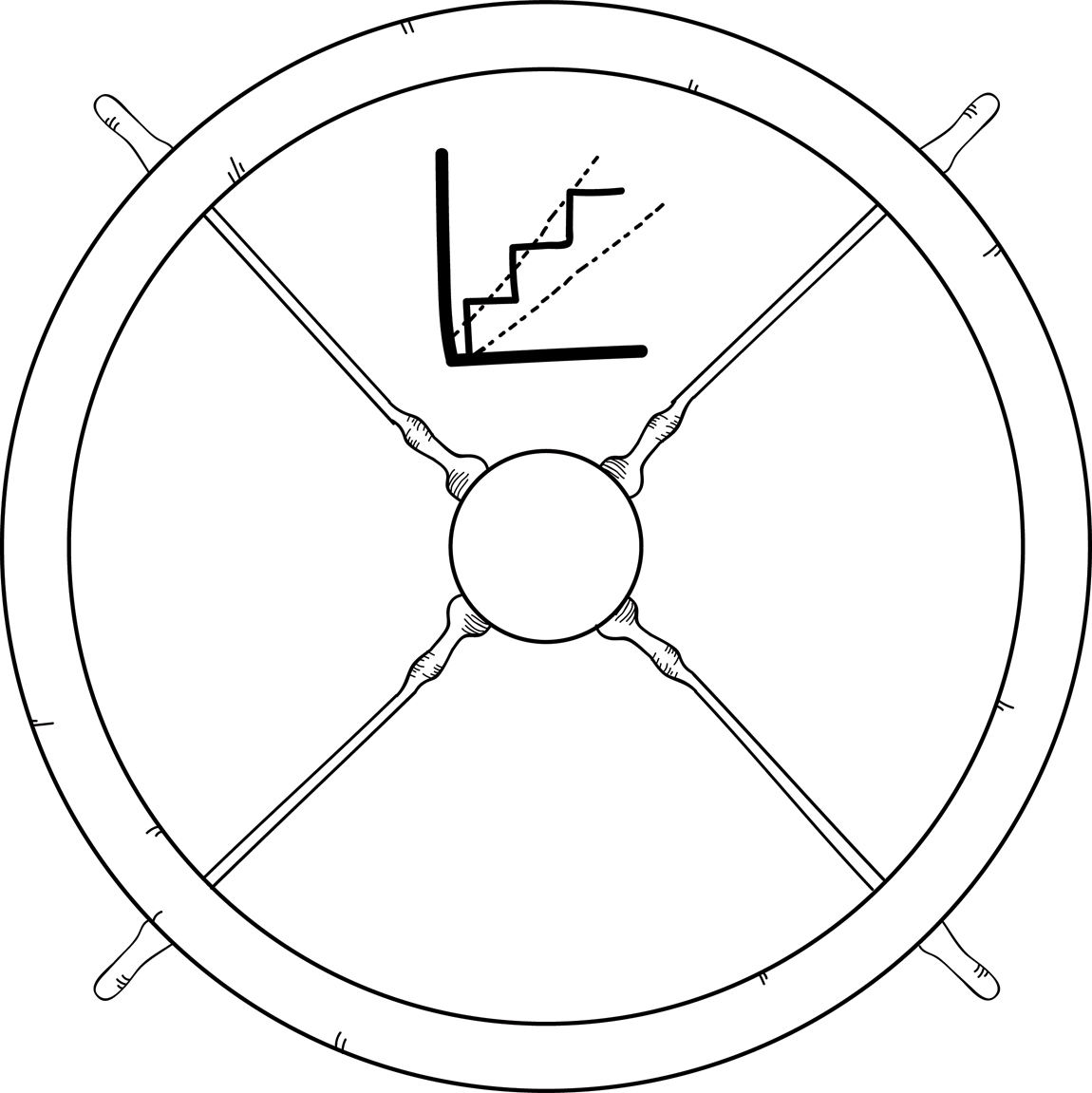
Introduction Questions
1. What makes your team interested in becoming more mature? What do they get in return?
2. Which employees dare to give you honest and strong personal feedback?
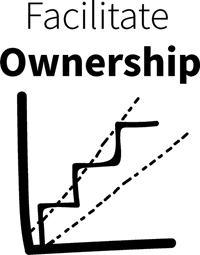
The Ownership Model requires some conditions to be satisfied in order to work.
Teams Need a Single Concrete, Shared Goal
A team can only self-organize if it is clear what they have to achieve. Without a concrete and shared goal, team members will perform their own work; the team ceases to function as a team. They fail to take on ownership, and the value delivered to customers suffers.
A KVI provides the team with a concrete and shared goal that supersedes individual goals. A single, concrete, shared goal helps the team come together to achieve the shared goal. In short, it helps them achieve ownership. As they continue to grow, they need lower and wider boundaries from their leader.
Teams Should Be Able to Give Open Feedback to the Leader to Maintain Ownership
Teams must be able to be transparent about how things are going, about what gives them energy, and about what frustrates them. Without open feedback, including feedback about how the agile leader is doing and feedback to each other, the team will become reactive; they will exhibit distrust, and they will hold back on their feedback. This kind of environment kills ownership. To create a culture of open feedback, trust, and learning, effective agile leaders have to set the right example. They need to make themselves open to feedback, even critical feedback. They need to be open about their own mistakes and shortcomings and ask for help from the team to grow continuously. They indicate what they are good at but also where they lack talents or skills. They talk about their own mistakes in a vulnerable and often humorous manner, and by doing so they make it safe for the rest of the team to do the same. This is the start of the kind of culture that allows ownership to flourish.
Teams Need to Focus on Working Smarter
Working harder doesn’t scale; if teams have to work harder to get better results, they will lack the time to learn and grow as a team. Highly mature teams make smart use of software to partially or fully automate their delivery processes. Doing so enables them to grow their customer impact while leaving time to continuously improve. Effective leaders value teams based on what achieve, not on what they do. For example, a team’s goal should be to increase customer satisfaction, increase use by the customer, or increase profit margin, not to increase the number of customer calls, the number of deliveries, or the number of new features shipped.
Quick Customer Appreciation
Users who are constantly very satisfied with what the teams do for them are likely to be served by a highly mature team. If the team receives feedback quickly and regularly from customers, they also gain quick insight into what they can improve. Agile leaders need to help teams shorten the learning loop with the customer (see Part 3). For example, if it takes 12 months to receive feedback on what they are doing today, giving teams more freedom is almost impossible (and has little value) because it’s virtually impossible to assess their maturity.
Agile Leaders Need to Escape The Yearly Employee Feedback Ritual
When agile leaders start using the Ownership Model, they are often trapped in ritualistic annual feedback and appraisal cycles. In the time gap between events and feedback, opportunities for improvement are lost. Feedback and assessment must be continuous to enable continuous improvement.
Resilience
Often, when leaders start using the Ownership Model, there is initially a lot of attention and focus on it. But too often this focus diminishes over time. Effective agile leaders show resilience and maintain this focus for several years in a row. It can take a lot of time to grow and nurture the teams and continuously improve the environment; this isn’t achieved in a few months. For agile leaders, the most important focus regarding their teams should be whether they are still in ownership. They continuously ask, “What can I do to improve your environment?” And this should not occur for the first months only; rather, agile leaders keep bringing that resilience.
Summary of Part 2—Facilitate Ownership
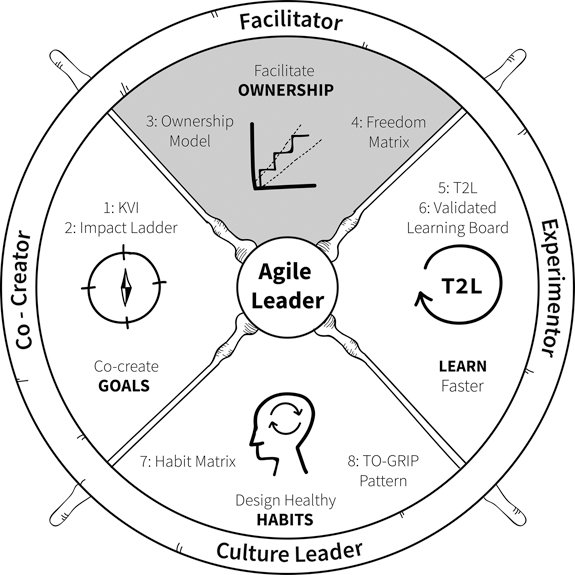
In this second part of the steering wheel, we look at how the leader can facilitate ownership. See the figure above for the visualization of Part 2. Self-managing teams need ownership to achieve their ambitions and objectives. Ownership is actually present when teams feel responsible and accountable for the results of their products and services. Teams that take on ownership are different from average teams; they are proactive and have both the passion and the energy to make an impact for customers. They work together, give each other feedback, are open-minded, and learn continuously. They also help other teams to grow. They also take ownership of both the strategy and its implementation. They have the deep understanding that they own their own challenges, solutions, and customers. This gives the teams pride, creativity, energy, passion, and satisfaction in their work.
Agile leaders can’t force teams to take ownership; they can only create an environment that encourages the teams to freely take ownership and supports them when they do. To create this supportive environment, the agile leader must intervene at the right moments and let go at the right moments, as guided by the maturity of the team. If the freedom the team is granted from their agile leader matches their maturity, the team will be given the right environment to take ownership.
The Ownership Model helps to make the relationship between maturity and freedom tangible. The Freedom Matrix provides a way to make freedom and maturity visible and concrete, by subject. See Figure 2.6 and Figure 2.7, respectively, for larger visualizations of these tools.
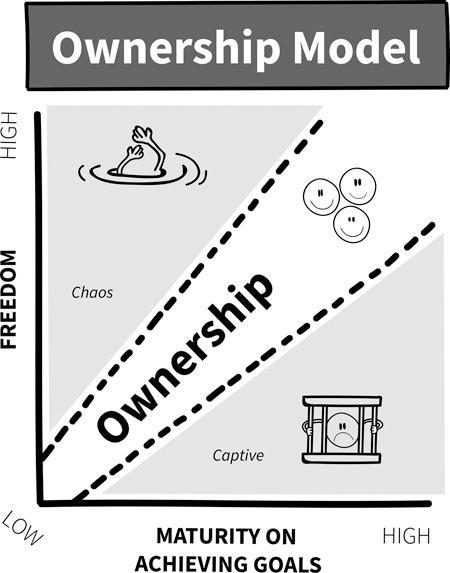
Figure 2.6 Large Ownership Model
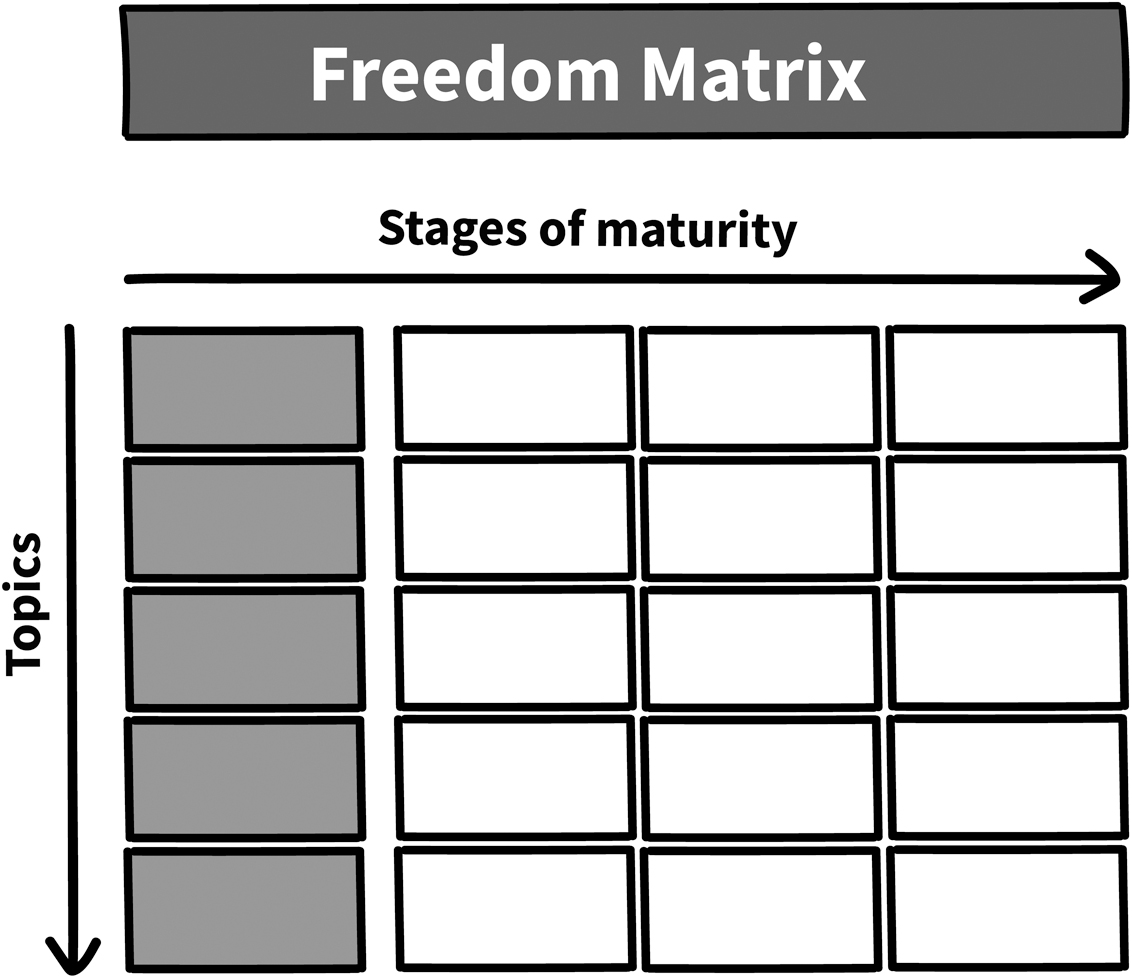
Figure 2.7 Large Freedom Matrix
The Agile Leader’s Responsibility to Facilitate Ownership in His Team(s)
When the work is complex, when teams have to grow continuously, and when the team members have to find creative solutions every day to really help customers, they need ownership to be successful. Ownership enables them to be creative and develop innovative solutions that benefit customers. These teams don’t wait for others come up with solutions and do not blame the circumstances; they are constantly looking for better solutions and new opportunities to better serve customers.
The agile leader’s most important responsibility is to facilitate an environment in which the teams can take ownership and, in doing so, to continuously improve as a facilitator. By doing so, he becomes increasingly skilled in the following:
Asking powerful questions of the team. Powerful questions increase creativity, promote honesty and transparency, stimulate out-of-the-box thinking, and focus on the outcome. By asking powerful questions, the teams are invited to take action, discover solutions, and make things clear and explicit.
Self-reflection. The behavior of the teams is a mirror of the environment we agile leaders create. Nobody comes to his or her work thinking, “Today I want to be demotivated, criticize others, and distrust my boss.” When people don’t have that spark in their eye called ownership, it’s not because they want it to be that way. It’s because we agile leaders haven’t yet improved the environment enough. Being a better facilitator of ownership goes hand-in-hand with being better at reflecting on one’s own behavior.
Team process. Good teams reflect, modify, and amplify each other’s ideas into even better ideas, seeking synergies to produce a better result. Together they are smarter than the sum of team members’ parts. Building these awesome teams is a difficult but crucial skill to master.
Growth of craftsmanship among team members. People in the successful agile teams are multiskilled, which means they master different areas of expertise. They need an environment that not only promotes knowledge transfer and skill development but also inspires them to become true craftsmen at several areas of expertise.
Tangible Actions
The following are some tangible actions to put the tools, examples, and ideas from Part 2 into practice.
Make explicit what you expect from high maturity teams. Share your vision of awesome and pinnacle teams. Make this as concrete and as stretching as possible.
Ask for concrete changes in freedom. Allow yourself to be surprised. Often the need for freedom of the team itself is different from what the agile leader expects.
Make your expectations about the growth of the teams concrete. Which stage in maturity do you expect the teams to go through in the coming six months? Help them reflect on what they will need from themselves, and from you, to get there.
Make team maturity deltas a focus of the team retrospectives. In addition to improving how the team works, make focus on the evolving maturity of the team one of the most important parts of team retrospectives.
Notes
_________________________________________________________________
_________________________________________________________________
_________________________________________________________________
_________________________________________________________________
_________________________________________________________________
_________________________________________________________________
_________________________________________________________________
_________________________________________________________________
_________________________________________________________________
_________________________________________________________________
_________________________________________________________________
_________________________________________________________________
_________________________________________________________________
_________________________________________________________________
_________________________________________________________________
_________________________________________________________________
_________________________________________________________________
_________________________________________________________________
_________________________________________________________________
_________________________________________________________________
_________________________________________________________________
_________________________________________________________________
_________________________________________________________________
_________________________________________________________________
_________________________________________________________________
_________________________________________________________________
_________________________________________________________________
_________________________________________________________________
_________________________________________________________________
_________________________________________________________________
_________________________________________________________________
_________________________________________________________________
_________________________________________________________________
_________________________________________________________________
_________________________________________________________________
_________________________________________________________________
_________________________________________________________________
_________________________________________________________________
_________________________________________________________________
_________________________________________________________________
